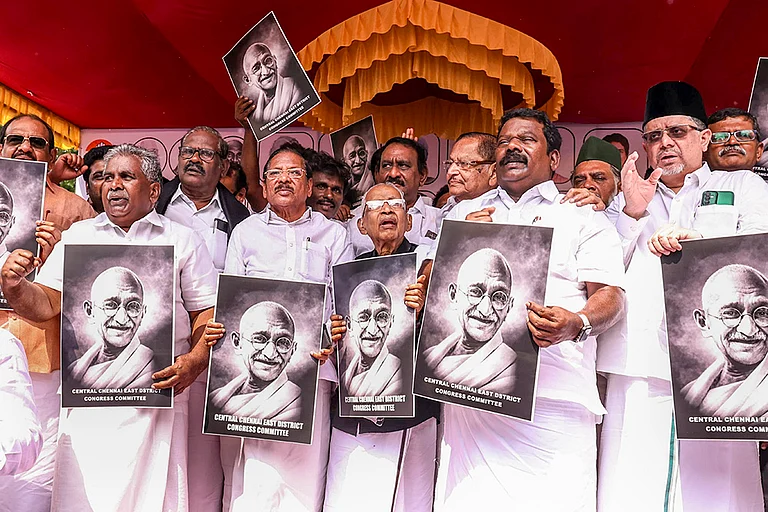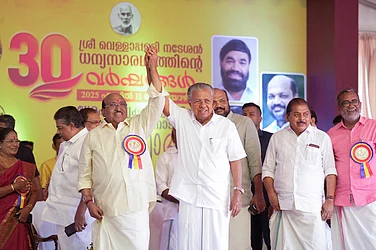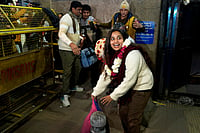AFTER the bridge spanning the Brahmaputra at its narrowest point near Guwahati, NH 52 runs east through typically verdant Assamese landscape. In the lineup of coconut, banana, arecanut and bamboo trees, paddy provides a light green backdrop, mustard fields add a splash of yellow. In between wind-sparkling streams and rivulets.
Villages contribute to the visual beauty. Each house has its own grove of fruit trees and, often, its own pond. Separated, not clustered, each is fenced with split bamboo, woven into distinct designs. The slender fences are to mark territory, not to protect. There's a general impression of tranquility.
That is, until we reach the reinforced concrete bridge beyond Mangaldai in Darrang district. It had been blasted five days earlier. We are able to negotiate the narrow passage repaired over it. The trucks carrying vital supplies to Arunachal and the Northeast border can't. More than 100 are lined up on either side. For, ulfa militants had just marked their founding day (the outfit is now going on 18) by blocking a national highway. Elsewhere, they'd blown a hole in a major oil pipeline and a gap in a railway bridge.
We turn north towards Bhutan, where there were reports of militants holding training camps and taking refuge. The previous day, a group had attacked the convoy of a Bhutanese army brigadier on a road approaching the border. He was injured, a major and his two men killed. The militants had escaped through the thick undergrowth, presumably into Bhutan.
The route now enters the heart of Bodo country. Yet, it seems more peacefully sylvan than the highway. Schoolgirls, in colourful Bodo sarong and blouse, walk or cycle past. As we approach the trijunction of Assam, Arunachal Pradesh and Bhutan, the ranges become higher on the Arunachal side; a rough track leads towards Bomdila and Tawang. A herd of five elephants grazes peacefully in a forest clearing on the Arunachal side of the river. Except for a row of colourful prayer flags on a low ridge, it's difficult to discern the international border with Bhutan. People cross freely in both directions.
On the return journey, we detour via Tangla, a small Assamese town on the Northeast Railway. It had been the scene of three grisly reprisal killings in late 1998, in one a woman had been cruelly maimed. Tangla was the headquarters of the army units posted in the area. The wall-size map in the Operations Room details the grim reality camouflaged by the scenic landscape; it's spotted with marks showing where incidents had occurred, places to be protected, militant hideouts and tactical arrangements.
No incidents had occurred in Tangla after the army instituted regular patrols. But the locals confess that shopkeepers, petty contractors, even officials, are compelled to make regular payments to militant groups, sometimes to rival ones. Extortion complaints are widespread. Militants say they want money to buy arms to fight the Indian security forces or their rivals, but many leaders are living in comfort abroad. They say they're fining contractors and officials known to be corrupt, but even innocent teachers are being forced to contribute.
The difference between appearance and reality is no less marked in the region dominated by ulfa. The countryside is fertile, villages clean, people approachable. The district towns of Nalbari and Barpeta seem normal. The teachings of 15th century Assamese reformer Sankaradeva have left a pervasive impress on daily life.But at the local Circuit House, journalists confirm accounts of militant extortion and security force terror.
We also receive confirmation of reports that Bodo Liberation Tigers had been originally trained and equipped by Indian intelligence to split the Bodo movement. Since the Bodo area is a belt between Assam, Bhutan and Arunachal, support for an autonomous Bodoland was presumably seen by home ministry strategists as a cushion between ulfa and possible hostile contacts from the North.
As elsewhere, this shortsighted counter-terrorist strategy has rebounded. As have efforts to split ulfa. From it has emerged sulfa, or surrendered ulfa, leading to gang wars in Guwahati itself. The total number of militant groups, living mostly on extortion, is said to have reached 70. Home minister L.K. Advani told Parliament recently that the number of their victims in 1998, up to December, was 463.
In many ways, dealing with Assam is more complex, and potentially explosive, than Kashmir. It's more open to diverse foreign influences. It has common borders with Bangladesh and is adjacent to Nepal, from which the flow of immigrants into the valley threatens to convert the original inhabitants into a minority. It has an open border with Bhutan which helps militants escape into their territory. Remote, unpopulated strips of small Northeastern states separate it from unsettled, drug-infested Myanmar. China claims Arunachal; its forces penetrated deep into it in '62 before retreating. Sustained domestic unrest can once again invite foreign intervention.
This is what makes alienation of a people linked by a narrow corridor to the rest of the country so serious. That they're mostly Hindus hasn't brought them closer. Historical and ethnic divergences have proved stronger, coupled by a feeling of neglect by the Centre. Fears of being converted into a minority in their own land have induced a siege mentality; visitors from other parts of the country are often asked: when did you come from India?
They're as much strangers to the rest of the country. Little is known of Assam's rich history; how its forces repulsed the Mughals when most of the subcontinent was subdued; how it was ruled for 600 years by a single dynasty until annexed by the British. Assam tends to be clubbed with the tribal states of the Northeast as remote and backward. Like the Mughals and the British before, Delhi tends to treat it as a troublesome outpost of empire; not as partners in a democratic enterprise ruled by consent.
Partition hit Assam particularly hard. Rail and river links with the rest of India were cut, leaving only a narrow corridor along which new rail tracks and roads had to be laid. Another consequence was more lasting; about a quarter million refugees were driven out of East Pakistan. They were Hindus, but they exacerbated fears of a Bengali-speaking state being carved out of Assam. The '71 war brought in another wave, many of them Muslims.
Assam blamed New Delhi for failing to stem the flow. Confidence in the Centre ebbed further following Nehru's broadcast confessing incapacity to defend the Northeast in '62. The separation of Nagaland, Manipur, Meghalaya, Arunachal, Mizoram heightened discontent, though it was the insistence on imposing the Assamese language that aroused unease. The process continues.
Ethnic dissension, continuing immigration and resentment over New Delhi's neglect has kept Assam in ferment. Assam's oil, tea, timber, jute and agricultural produce make it one of the richest states in India in natural wealth. But most of the revenue goes elsewhere, the employment to outsiders. Assamese leaders cite figures to show that while the state produces some 80 per cent of India's onshore oil production, it gets less than Rs 30 crore a year in revenue, while the Centre appropriates over Rs 600 crore.The main refinery is in Barauni though Bihar produces no oil. The natural gas is wasted. ongc headquarters are in distant Dehradun. Assam tea brings India an estimated Rs 3,000 crore annually, of which the state gets less than Rs 150 crore. Calcutta gets the benefit of auctioning the bulk of the tea. Most of Assam's jute feeds mills in Calcutta, whereas its own industrial development is stunted.
National security has been cited as a reason for the failure to build Assam's industry. The shadow of '62 lingers. But the prolonged failure to regain confidence in New Delhi may prove the bigger threat. Today, more of the 200,000 troops and paramilitary forces in Assam are performing internal security duties rather than protecting our borders.


























